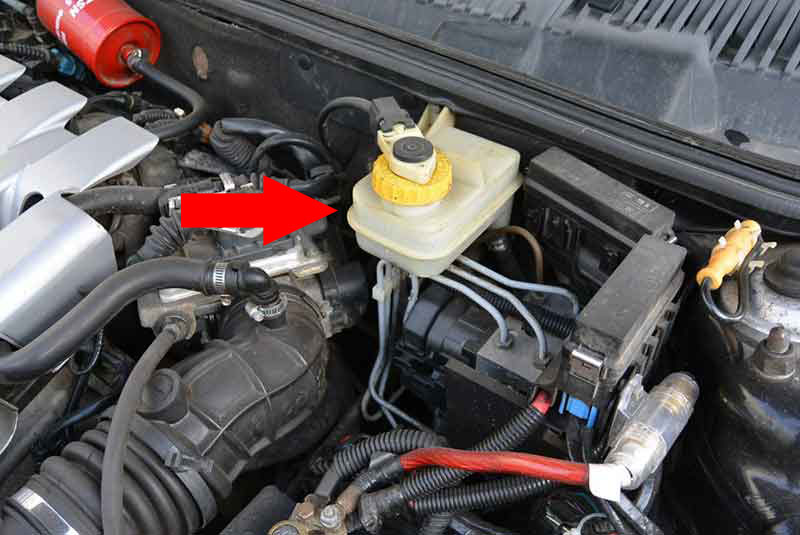Have you ever worked up in one morning and realized a brownish or light yellow spot near the wheels of your car? This can be a clear indication that your brake fluid is leaking from the car’s brake system.
You can confirm whether it is brake fluid by touching the fluid spot on the ground and if it leaves residues slippery like on your fingers, that is it.
Your car’s brake system is featured to operate on a closed system basis and includes a reservoir, brake fluid, links, pistons, various cylinders, brake lines, various switches, and brake pedals. If one of these components fails or gets damaged, the result is that brake fluid starts leaking.
There are several causes of brake system failure, including worn-out brake fluid, which damages the brake pads. Worn-out brake fluid doesn’t depress the brake pads, and therefore, the brake system efficiency is lost; you may start hearing a noise like squealing, squeaking, or grinding while using the brakes.
All this results in most when there is uneven wear of the brake pads.
However, if you want to care about your car’s brake system, you need to replace the worn-out brake fluid. In most cases, you can add brake fluid by bleeding the system.
Bleeding in brake fluid is where you ride the trapped air and expel old fluid from the brake system. But can you add brake fluid without bleeding? The answer to this question is yes, you can add brake fluid without bleeding.
Bleeding in the brake system is not compulsory in the process of adding brake fluid to your car. Bleeding is only applicable or necessary once you push the brake pedal or drain the reservoir completely.
In other words, you only use bleeding if there is leakage that has caused air bubbles into the brake fluid pipes or lines.
Contents
How to add brake fluid
Brake fluid is necessary for any car as it keeps the brakes working. You should regularly check your car’s brake fluid condition and fill it if it is discolored or low. A well-functioning brake system is vital for a car’s general health and safety.
While replacing worn-out brake parts is crucial, there are some parts that people tend to overlook while inspecting.
Brake fluid is one of the major components that should be inspected as it plays a vital role in keeping the brakes functional. In case your fluid is low or disclosed, here is how to add it.
1. Park your car in a leveled place
Ensure that you position your car on a level surface and that it is stationary. This is to ensure you get correct brake fluid readings, as having the vehicle at a steep pitch will lead to incorrect readings of brake fluid.
2. Depress the brake lever twenty to thirty times
If your vehicle has anti-lock brakes, press them about twenty to thirty times. However, if it does not, be free to skip the step.
3. Find where the brake fluid tank is located.
The brake fluid tank is located under the hood on the car’s driver’s side against the back engine compartment. However, some have the brake fluid tank located under a plastic entrance panel.

4. Assess the level of the brake fluid
Check to see the level of your car’s brake fluid. Most modern cars have transparent plastic tanks with maximum and minimum marks on them for easy examination.
5. Exam the fluid’s color
Brake fluids often become contaminated with everyday use. For example, a clean brake fluid takes a light golden yellow color, but it changes to dark amber when it is contaminated. If it is contaminated, contact a professional, but if clean, proceed to the next step.
6. Open the cap and open the fluid tank.
If you find the fluid below the minimum mark, or you cannot see its level with the old one, open it.
7. Clean the reservoir
Take a clean cloth and clean all grease and dirt from the top of the reservoir and cap.
8. Remove the lid
Now remove the lid by unscrewing it, releasing the metal spring clip, or pulling it straight.
9. Add brake fluid to the tank.
Slowly add the fluid to the reservoir until it reaches the maximum level. Ensure you don’t fill beyond the mark.
10. Return the cap to the reservoir
Now you are done, simply reinstall the fluid tank cap the way you removed it.
Conclusion
Caring about your car’s health is always the bright idea to make your car operate efficiently, avoid accidents, and have a long lifespan.
You can achieve this by paying attention to the check-up schedule and repairing the most damaged parts, including the brake system.
Brake parts like brake pads can fail due to worn-out brake fluid, failing the whole system. Therefore, replace or add brake fluids, and it is not mandatory to use bleeding.
